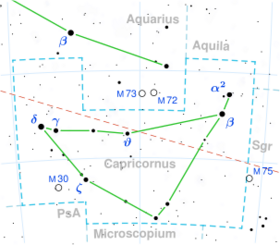Astronomy:Lambda Capricorni
| Observation data Equinox J2000.0]] (ICRS) | |
|---|---|
| Constellation | Capricornus |
| Right ascension | 21h 46m 32.09739s[1] |
| Declination | −11° 21′ 57.4391″[1] |
| Apparent magnitude (V) | +5.56[2] |
| Characteristics | |
| Spectral type | A1 V[3] |
| B−V color index | −0.01[2] |
| Astrometry | |
| Radial velocity (Rv) | −2.4[4] km/s |
| Proper motion (μ) | RA: +28.92[1] mas/yr Dec.: −9.66[1] mas/yr |
| Parallax (π) | 11.58 ± 0.30[1] mas |
| Distance | 282 ± 7 ly (86 ± 2 pc) |
| Absolute magnitude (MV) | +0.89[5] |
| Details | |
| Mass | 2.50[6] M☉ |
| Radius | 2.2[7] R☉ |
| Luminosity | 45[5] L☉ |
| Surface gravity (log g) | 4.15±0.14[6] cgs |
| Temperature | 10,674±363[6] K |
| Rotational velocity (v sin i) | 192.5±5.7[8] km/s |
| Age | 155[6] Myr |
| Other designations | |
| Database references | |
| SIMBAD | data |
Lambda Capricorni, Latinized from λ Capricorni, is a solitary[10] star in the southern constellation of Capricornus. It is faintly visible to the naked eye with an apparent visual magnitude of +5.56.[2] Based upon an annual parallax shift of 11.58 mas as seen from the Earth,[1] the star is located about 282 light years from the Sun. At that distance, the visual magnitude is diminished by an extinction factor of 0.11 due to interstellar dust.[11]
This is a white-hued A-type main sequence star with a stellar classification of A1 V.[3] It is a magnetic Ap star, indicating the spectrum displays chemically peculiar features.[8] The star has an estimated 2.50[6] times the mass of the Sun and about 2.2[7] times the Sun's radius. It is 155[6] million years old and is spinning rapidly with a projected rotational velocity of 192.5 km/s.[8] Lambda Capricorni is radiating 45[5] times the Sun's luminosity from its photosphere at an effective temperature of 10,674 K.[6]
References
- ↑ 1.0 1.1 1.2 1.3 1.4 1.5 van Leeuwen, F. (2007), "Validation of the new Hipparcos reduction", Astronomy and Astrophysics 474 (2): 653–664, doi:10.1051/0004-6361:20078357, Bibcode: 2007A&A...474..653V.
- ↑ 2.0 2.1 2.2 Corben, P. M.; Stoy, R. H. (1968), "Photoelectric Magnitudes and Colours for Bright Southern Stars", Monthly Notes of the Astronomical Society of Southern Africa 27: 11, Bibcode: 1968MNSSA..27...11C.
- ↑ 3.0 3.1 Royer, F. et al. (February 2007), "Rotational velocities of A-type stars. III. Velocity distributions", Astronomy and Astrophysics 463 (2): 671–682, doi:10.1051/0004-6361:20065224, Bibcode: 2007A&A...463..671R.
- ↑ Gontcharov, G. A. (November 2006), "Pulkovo Compilation of Radial Velocities for 35495 Hipparcos stars in a common system", Astronomy Letters 32 (11): 759–771, doi:10.1134/S1063773706110065, Bibcode: 2006AstL...32..759G.
- ↑ 5.0 5.1 5.2 Anderson, E.; Francis, Ch. (2012), "XHIP: An extended hipparcos compilation", Astronomy Letters 38 (5): 331, doi:10.1134/S1063773712050015, Bibcode: 2012AstL...38..331A.
- ↑ 6.0 6.1 6.2 6.3 6.4 6.5 6.6 David, Trevor J.; Hillenbrand, Lynne A. (2015), "The Ages of Early-Type Stars: Strömgren Photometric Methods Calibrated, Validated, Tested, and Applied to Hosts and Prospective Hosts of Directly Imaged Exoplanets", The Astrophysical Journal 804 (2): 146, doi:10.1088/0004-637X/804/2/146, Bibcode: 2015ApJ...804..146D.
- ↑ 7.0 7.1 Pasinetti Fracassini, L. E. et al. (February 2001), "Catalogue of Apparent Diameters and Absolute Radii of Stars (CADARS)", Astronomy and Astrophysics 367: 521–524, doi:10.1051/0004-6361:20000451, Bibcode: 2001A&A...367..521P.
- ↑ 8.0 8.1 8.2 Wraight, K. T. et al. (February 2012), "A photometric study of chemically peculiar stars with the STEREO satellites - I. Magnetic chemically peculiar stars", Monthly Notices of the Royal Astronomical Society 420 (1): 757–772, doi:10.1111/j.1365-2966.2011.20090.x, Bibcode: 2012MNRAS.420..757W.
- ↑ "lam Cap". SIMBAD. Centre de données astronomiques de Strasbourg. http://simbad.u-strasbg.fr/simbad/sim-basic?Ident=lam+Cap.
- ↑ Eggleton, P. P.; Tokovinin, A. A. (September 2008), "A catalogue of multiplicity among bright stellar systems", Monthly Notices of the Royal Astronomical Society 389 (2): 869–879, doi:10.1111/j.1365-2966.2008.13596.x, Bibcode: 2008MNRAS.389..869E.
- ↑ Gontcharov, G. A. (November 2012), "Spatial distribution and kinematics of OB stars", Astronomy Letters 38 (11): 694–706, doi:10.1134/S1063773712110035, Bibcode: 2012AstL...38..694G.
 |


